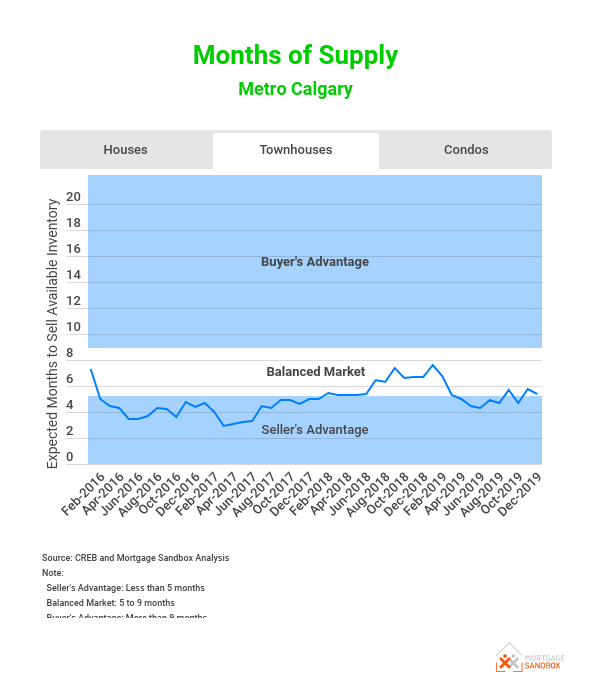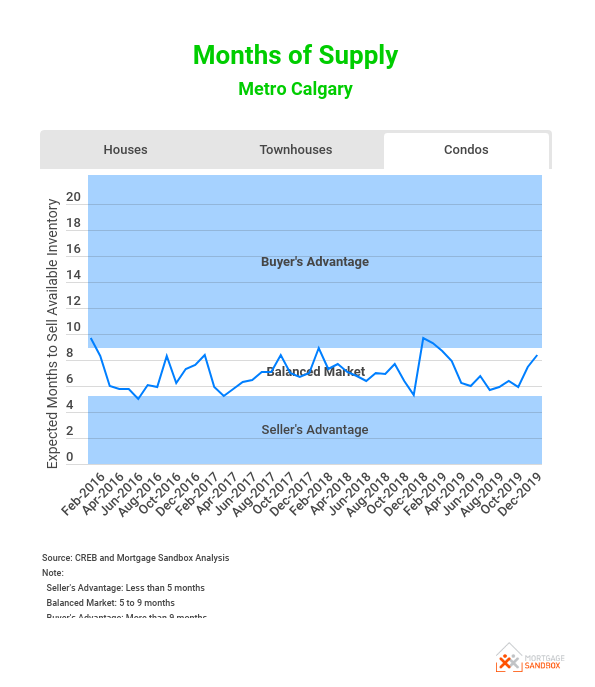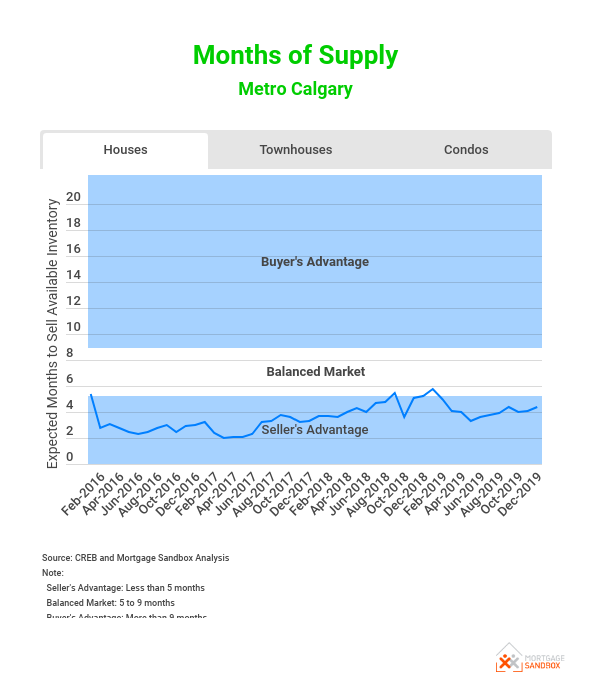Metro Calgary Real Estate Forecast - Jan 2020
HIGHLIGHTS
|
This article covers:
Where are Metro Calgary prices headed?
What factors drive the price forecast?
Should investors sell?
Is this a good time to buy?
1. Where are Metro Calgary prices headed?
Home Price Overview
The good news (for buyers) is that prices have moderated significantly in the past year and there is less risk of being priced out of the market. People planning to sell their home will take heart in the fact that home values didn’t drop as they did in Vancouver and Edmonton so they needn’t rush to sell.
In this section, we review recent price trends for houses, townhouses and condos in the Metro Calgary area and then share a forecast developed with input from a range of leading Canadian forecasters. If you would like to skip the current trends, you can scroll ahead to the 2021 Metro Calgary Home Price Forecast.
Metro Area Detached House Prices
House prices are entering 2020 at values almost the same as they began in 2019. Perhaps this is the “soft landing” that government policymakers are targeting? With more moderate price movements, we may see a return to the typical seasonal real estate cycle and price growth in the range of 1 to 3% annually – in line with income growth.
Although benchmark house prices in some parts of the Calgary Area are stable, in some sub-markets house prices have surged while in other sub-markets prices have been dropping. For example, in 2019 prices in Calgary South rose by 2.7% while prices in Calgary west dropped 3.4%.
Metro Calgary Condo Prices
Metro Calgary apartment prices have been sliding downward for years but since mid-2019 they have decelerated and are drifting downward at a much slower pace. Today, a benchmark Metro Calgary condo is affordable without help from the bank of mom and dad. A benchmark Calgary apartment is still more expensive than an Edmonton apartment but it is cheaper than a benchmark condo in any other major Canadian city including Ottawa and Montreal.
Although sales are picking up, prices are still relatively flat because there is plenty of condo supply. If supply continues to come to market, the more expensive, higher quality, and larger (i.e., 2 and 3 bedrooms) condos will drop in price and this will shift the prices downward for more modest condos.
Metro Calgary Townhouse Prices
Very affordable for first-time homebuyers
Since Calgary home prices have moderated they have become very affordable. A first-time homebuyer household earning $99,000 (the median Metro Calgary household before-tax income) can get a $345,000 mortgage. That’s more than enough to buy a benchmark $250,000 condo but to buy a $500,000 house a first-time homebuyer needs to save about $150,000 cash for a down payment or receive a very generous gift from mom and dad. For most people, that’s just not on the cards.
What about the rest of the West?
Read the Vancouver Real Estate Forecast and Edmonton Real Estate Forecast.
2021 Metro Calgary House Price Forecast
At the beginning of 2019, Royal LePage predicted house prices in Metro Calgary would drop 2.4% in 2019 while the Calgary Real Estate Board forecast a 3.71% drop. In the end, these forecasters were too pessimistic about the house market and too optimistic about the condo apartment market, a benchmark Metro Calgary house value barely budged in 2019.
The regional performance also hides some variation. As mentioned earlier, prices in Calgary South rose by 2.7% while prices in Calgary west dropped 3.4%. This is the difficulty with regional forecasts…real estate is local.
For 2020, we expect Metro Calgary to experience seasonal price variations that are reflective of a more balanced market. The average of the forecasts used in our analysis predicts a modest rise of 1 to 2% each of the next two years. CMHC provides a range and their best-case scenario results in a price rise of 2% in 2020 but their pessimistic scenario sees prices drop 1%. There is still a pile of risks that could derail a price recovery and 2020 is unlikely to be a return to the booming real estate prices of the early 2000s.
We expect high-end areas and luxury properties to underperform in 2020.
At Mortgage Sandbox, we provide a price range rather than attempting a single prediction because there are many risks in real estate that can impact prices. Risks are events that may or may not happen so as a result, we review a variety of forecasts from leading lenders and real estate firms and we present the most optimistic forecast, the most pessimistic forecast, and the average forecast. Want to learn more about real estate risk? We’ve written a comprehensive report that explains the level of risk in the Canadian real estate market.
Our forecast inputs:
2. What factors drive the price forecast?
Mortgage Sandbox 5 Factor Framework
At the highest level, supply and demand set house prices and all other factors simply drive supply or demand. At Mortgage Sandbox, we have created a five-factor framework for gathering information and performing our market analysis. The five key factors are affordability, capital flows, government policy, supply, and popular sentiment. Below we will summarize how the five factors result in the current forecast.
Affordability
Affordability is a function of:
Home Prices: The current market value of the desired home.
Savings-Equity: How much disposable after-tax income you’ve been able to squirrel away plus any equity you have in your existing home.
Financing: This is driven by income levels (i.e., how much money you can put toward mortgage payments) and interest rates (how big are the mortgage payments).
Increased affordability raises buyer purchasing capacity and puts upward pressure on prices while dropping affordability has the opposite effect.
How has affordability changed lately?
Home prices: From the peak, prices have dropped 9 to 21% depending on where you’re looking and what type of home you want. Lower prices improve affordability and improved affordability adds upward pressure on prices. That may explain why home prices haven’t been dropping as quickly of late, but Calgary homes were always relatively affordable so affordability was never an issue holding prices down.
Savings-Equity: With rents rising in line with incomes (1.7%) and vacancy rates running at a healthy 3.9%, first-time buyers should not struggle to set aside cash for a down payment and since homes prices have kept their value in the last 12 months most homeowners will have a little more home equity going in 2020 than they did in 2018.
Financing: Median incomes have not changed materially and are still among the highest in Canada and mortgage qualifying interest rates dropped about 9% since 2018. This means Calgarians have the highest home buying budgets of anyone in Canada. Most forecasts predict mortgage qualifying rates will rise in 2020. Lower interest rates are a major factor driving home prices.
Over the course of 2019, Calgary’s amazingly good affordability has improved and this will add some fuel to home prices coming into 2020. Edmonton Real Estate Forecast
Capital Flows
These represent short-term investment, long-term investment, and recreational demand (i.e., not occupied full-time by the owner). Here is where foreign capital, real estate flippers, and dark money come into play. It also includes short-term rentals, long-term rentals, and recreational property purchases.
Capital inflows raise demand and put upward pressure on prices while capital outflows have the opposite effect. If capital sits invested in real estate nothing is bought or sold, it has no effect on the direction of prices.
Foreign capital inflows are a major influence in Vancouver and Toronto but are less of a concern in Calgary. As well, Alberta hasn’t enacted any new policies that would change the flow of capital to the province.
Calgary also hasn’t seen rampant house flipping. To provide a comparison, Vancouver had very high house flipping activity before the financial crisis then it dropped dramatically. It picked-up again in 2016-17 and then declined again in 2019 because it’s difficult to profitably flip homes with quick renovations when the value of the land value is dropping. The chart below shows the changes in Metro Vancouver and we would like to provide a similar one for Calgary but it’s difficult to find an equivalent analysis for Calgary.
As it relates to our analysis, we expect domestic interest in rental income properties is unchanged.
As well, we see no evidence of a diminished role for dark money in local real estate. A recent report says Alberta is to blame for the majority of Canada’s money laundering and another eye-opening report by Royal LePage says many homes purchased in Ontario and B.C. are bought by Canadian residents on student visas. In Vancouver, students buy twice as many homes as permanent resident couples with no children. In B.C. and Ontario, it would appear that the parents of students are using their children to evade the Foreign Buyer Tax but there is no incentive to do this in Alberta.
We believe there is no net change in capital inflows toward residential real estate.
Government Policy
There has been a lot of policy aimed at housing in recent years but we are mostly concerned with any recent changes that impact the real estate market. Changes made in 2018 and earlier are pretty much already “baked-in”.
In September 2019, the federal liberals created the First-Time Home Buyer Equity Incentive to help people purchase their first home. Under the program, the government offers to put in equity worth 5% or 10% of the home’s purchase price. It is difficult to qualify and it has a lot of strings attached so we expect it will have little effect in the Metro Calgary market.
BC’s Corporate Beneficial Ownership Registry comes into effect in May of 2020 and this may shift some foreign investment to Alberta. Unfortunately, this may not be the kind of investment that most locals are hoping for.
The federal mortgage stress test implemented in 2018 effectively reduces the amount home buyers can borrow by 20% and its short term impact has been fully absorbed in home prices. It will have no incremental impact in 2020.
Up until now, the desired effect of the federal, B.C. and Ontario policies is to reduce unnecessary demand until more supply can come to the market. The net effect may be to shift speculative interest to Alberta and Quebec who have not changed housing policy. If prices fail to moderate in Vancouver and Toronto, then we should expect more government policy interventions and more price uncertainty.
Supply
Supply comes from two sources.
Existing sales: Homes owned by individuals who sell them to upgrade, because they are moving for work, or some other reason. This is the primary source of detached single-family houses since very few new houses are being built in Metro Calgary.
Pre-Sales and Construction Completions: Usually, up to 70% of new homes are sold via pre-sales before the construction is completed. These are predominantly apartments and townhomes. Data on pre-sales is private and more difficult to find whereas construction starts and completions are reported by the government.
Rising supply releases the upward pressure on prices caused by demand.



Months of Supply of Existing Homes
In recent months, sales have increased to healthier levels but haven’t broken any records. The true driver of price stability has been reduced supply. The ratio between purchases and active listings is trending toward a balanced condo market and a house market that favours sellers. The net effect is that price growth should be flat in the near-term because, in a balanced market, buyers and sellers negotiate can both negotiate on an even footing. Sellers will not be offering much in the way discounts and incentives, nor will there be bidding wars or no-subject offers. The market is just a little less stressful for everyone.
Baby Boomers Downsizing?
In 2020, 45% of baby boomers will be aged 65 and over and, according to a recent survey, 44 percent of Alberta Boomers who own a home plan to downsize in the retirement and 45 percent would consider a condo apartment for their next purchase. A recent report on all Canadian Boomers from RBC says, “Over the coming decade, we expect baby boomers to ‘release’ half a million homes they currently own—the result of the natural shrinking of their ranks, and their shift to rental forms of housing, such as seniors’ homes, for health or lifestyle reasons.”
As baby boomers begin downsizing and list their half-million-dollar homes for sale they will add supply in what is considered the luxury market. If not enough Gen-X and millennial buyers can be found for these expensive homes, there is a risk that this may depress prices at the top of the market, which will then compress prices for townhomes and condo apartments.
In the near-term supply is balanced, but in the medium-term, there are risks of higher than expected supply.
Mortgage Delinquencies and Foreclosures
The most recent data indicates that more Canadians are missing their monthly payments and job growth has been healthy. Some economists have been warning of a recession and even without a recession, it appears more Canadians are over-extending themselves. Even though delinquency rates are relatively low, it is surprising that the increases in mortgage delinquencies are led by Ontario and British Columbia, and not Alberta.
According to Equifax, the credit bureau company:
“Mortgage delinquencies have also been on the rise. The 90-day-plus delinquency rate for mortgages rose to 0.18 percent, an increase of 6.7 percent from last year. Ontario (17.6%) led the increases in mortgage delinquency followed by British Columbia (15.6%) and Alberta (14.8%). The most recent rise in mortgage delinquency extends the streak to four straight quarters.”
A recent survey by MNP reported a staggering number of Canadians are stretched to their limits:
“Over 30 percent of Canadians say they’re concerned that rising interest rates could push them close to bankruptcy, according to a nationwide survey conducted by Ipsos on behalf of MNP, one of the largest personal insolvency practices in the country.”
Pre-sales and Completions
New Construction: Near-record number of condos were built in 2019 and although housing starts have dropped the demand from Baby Boomers should continue to provide support for apartment construction. As more buildings complete in 2020 and 2021, and people move out of their rental or sell their current home, this new supply should help maintain a balanced market.
Pre-sales: Pre-sales, which are purchases of brand-new homes from developers, have trended down substantially in B.C. and Ontario since 2018. We have no direct data for Calgary but the slightly lower housing starts are a good indicator that pre-sales have softened. Since developers need to sell at least 70% of a project to secure financing and begin construction, they will likely try to entice buyers with price discounts, move-in allowances, and cool amenities. We recently received a pre-sale ad that offered homes for sale with only a 5% deposit when normally a 20% deposit is required for pre-sales!
Popular Sentiment
Buyers who were sitting on the sidelines are now springing into action but sellers, who remember when their home worth 10% more, may be reluctant to sell. At its core, seller reluctance is what is holding prices up. If listings rise, then the market will tilt in favour of buyers and prices will drop. There’s no way of predicting seller sentiment but, as witnessed in the past two years, sentiment can shift quickly.
3. Should Investors Sell?
From a seller’s perspective, there are more changes in the market that influence prices downward so now may be a better time to sell than in two years and the seasonal real estate cycle usually favours sellers in the first half of the year.
Sellers should always consult a mortgage broker early to prioritize flexible loan conditions and reduce the risk of mortgage cancellation penalties. Find out more about the benefits of a mortgage broker.
4. Is this a good time to buy?
With lower prices, homebuyers who waited from 2018 to 2020 have been rewarded. With prices now stabilizing, 2020 definitely appears to be a favourable time to buy. Looking forward to 2021, prices may be higher or lower but they are unlikely to rise dramatically so buyers shouldn’t feel the need to rush to an offer. Also, keep in mind that the seasonal real estate cycle usually favours buyers in late summer.
If you are thinking of buying just be sure to drive a hard bargain and cover your bases with smart and educated decisions. Don’t bite off more than you can chew.
Buying a home is a big decision, so check out Mortgage Sandbox’s Canadian Homebuyer Guide so we can walk you through the end-to-end process and get you ready to buy your new home!
Here are some recent headlines you might be interested in:
Home prices in Alberta expected to rise in 2020: Royal LePage Market Survey Forecast (CTV News)
Calgary housing market forecast brightens modestly over next two years (Calgary Herald)
Calgary housing market among the most affordable in Canada, report says (CBC)
'We're a bit stuck': CEO of Alberta bank expects province's economic struggles to continue (CBC)
Calgary's resale housing market showed positive signs in August (London Free Press)
Sales of lower-priced homes give Calgary's real estate market modest boost (CBC)
Canada’s Risky Housing Market Has Traded Places With The U.S., IMF Says (Huffpost)
Assessing whether 2020 will bring a Canadian property tumble (CBC)
Should Canada ban non-residents from buying homes? (The Star)













